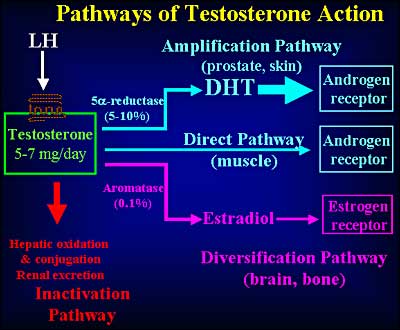
FIGURE 2. Pathways of Testosterone Action . In men, most (>95%) testosterone is produced under LH stimulation through its specific receptor, a heptahelical G-protein coupled receptor located on the surface membrane of the steroidogenic Leydig cells. The daily production of testosterone (5-7 mg) is disposed along one of four major pathways. The direct pathway of testosterone action is characteristic of skeletal muscle in which testosterone itself binds to and activates the androgen receptor. In such tissues there is little metabolism of testosterone to biologically active metabolites. The amplification pathway is characteristic of the prostate and hair follicle in which testosterone is converted by the type 2 5 a reductase enzyme into the more potent androgen, dihydrotestosterone. This pathway produces local tissue-based enhancement of androgen action in specific tissues according to where this pathway is operative. The local amplification mechanism was the basis for the development of prostate-selective inhibitors of androgen action via 5 a reductase inhibition, the forerunner being finasteride. The diversification pathway of testosterone action allows testosterone to modulate its biological effects via estrogenic effects that often differ from androgen receptor mediated effects. The diversification pathway, characteristic of bone and brain, involves the conversion of testosterone to estradiol by the enzyme aromatase which then interacts with the ERs a and/or b . Finally the inactivation pathway occurs mainly in the liver with oxidation and conjugation to biologically inactive metabolites that are excreted by the liver into the bile and by the kidney into the urine.
